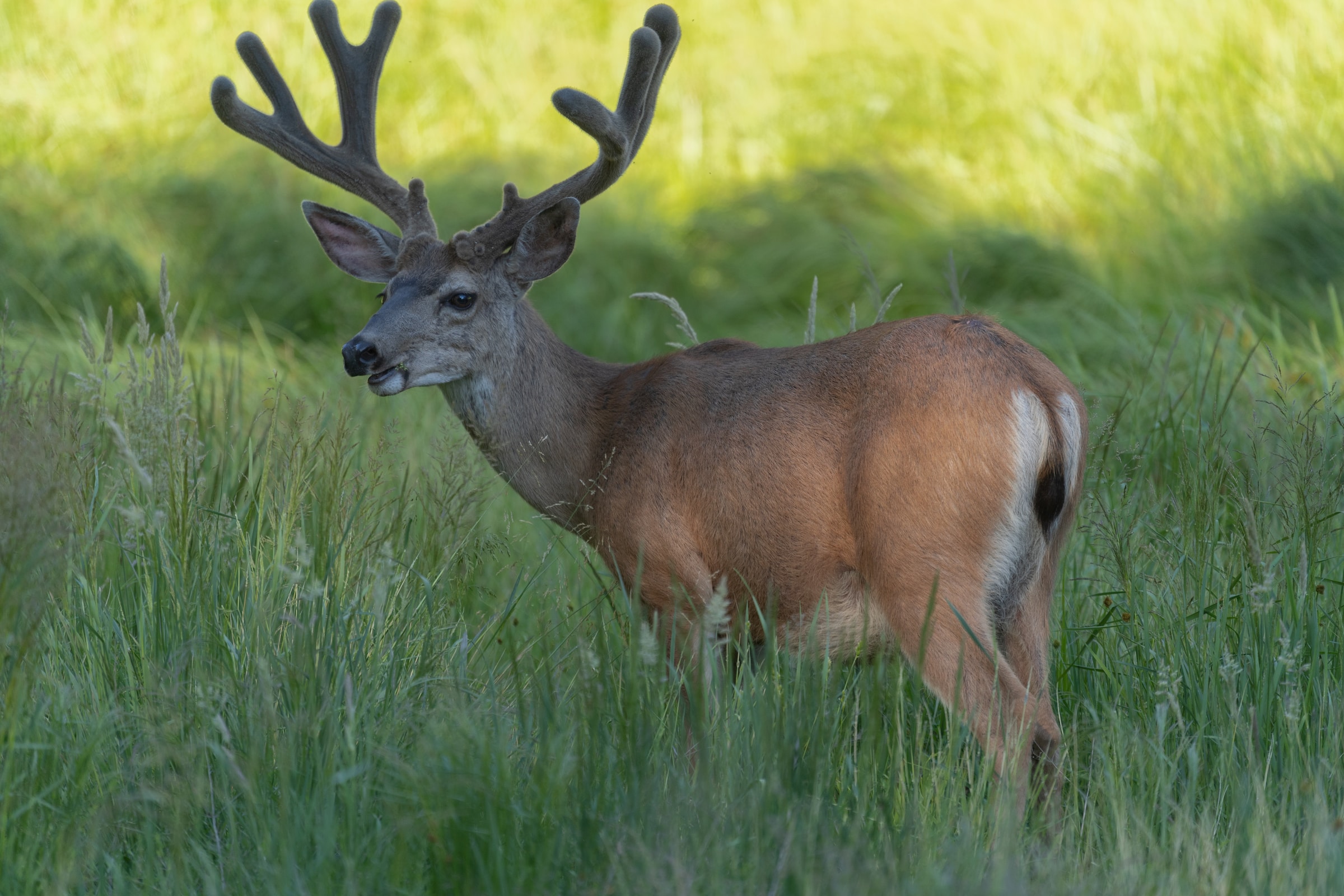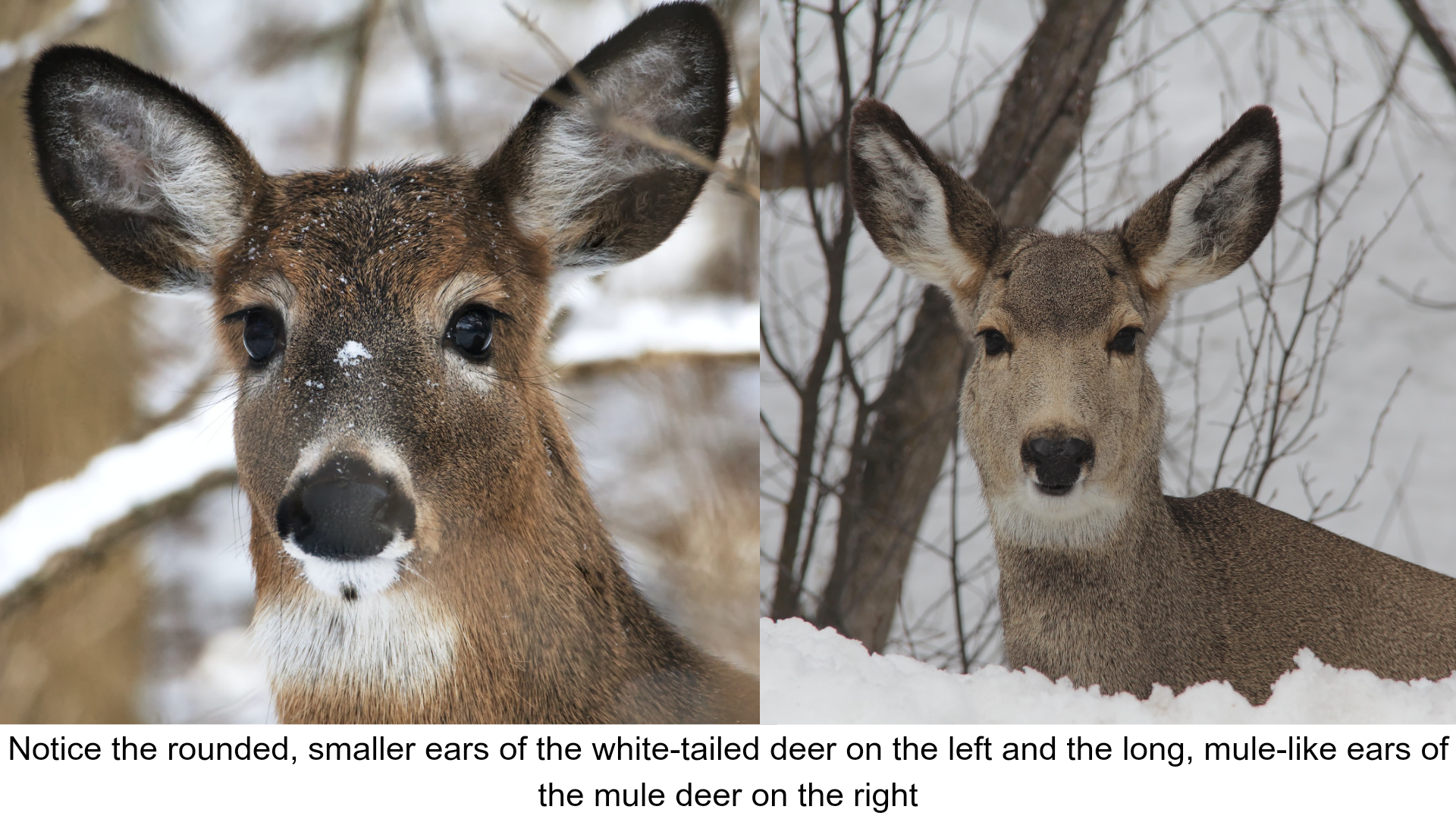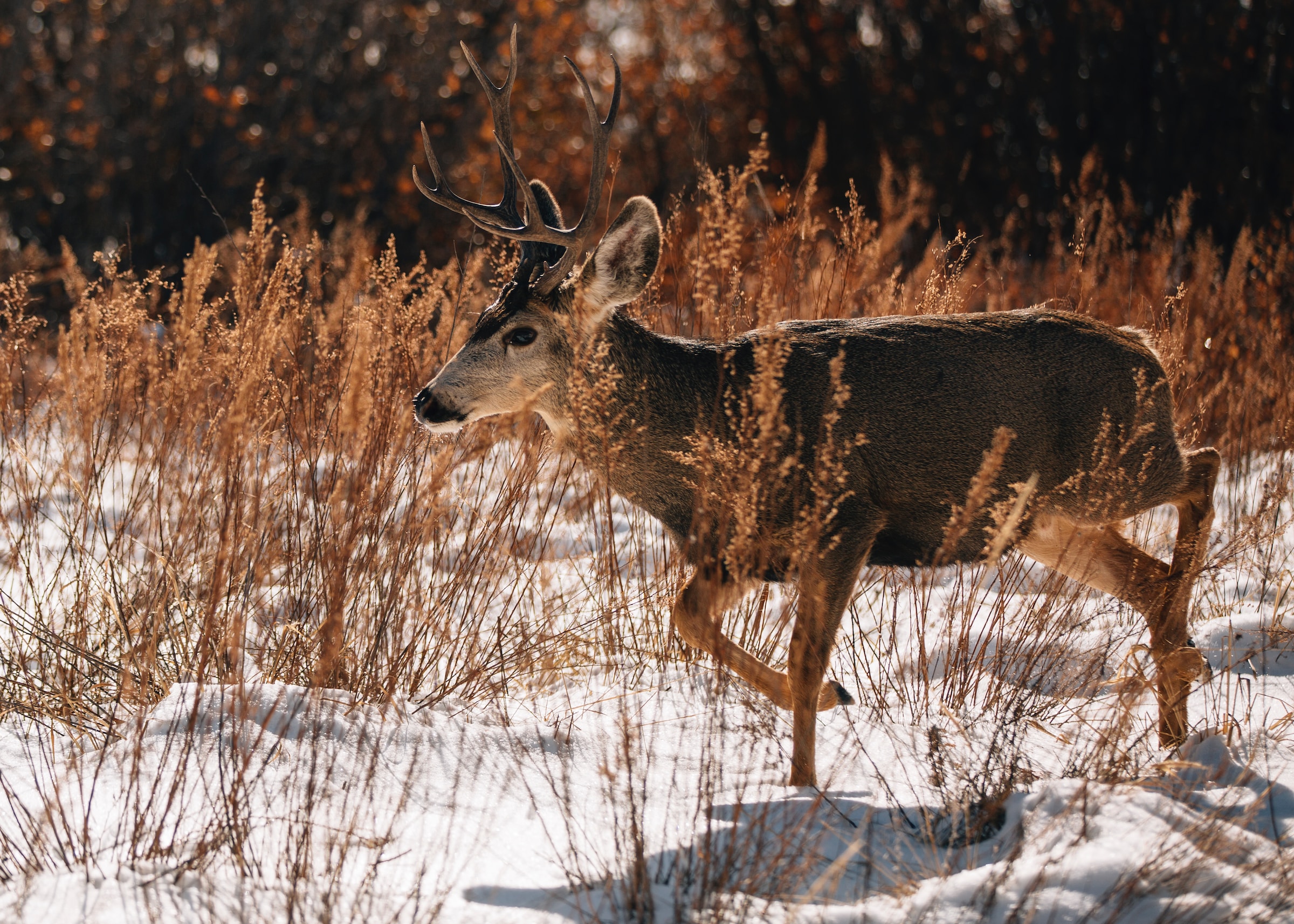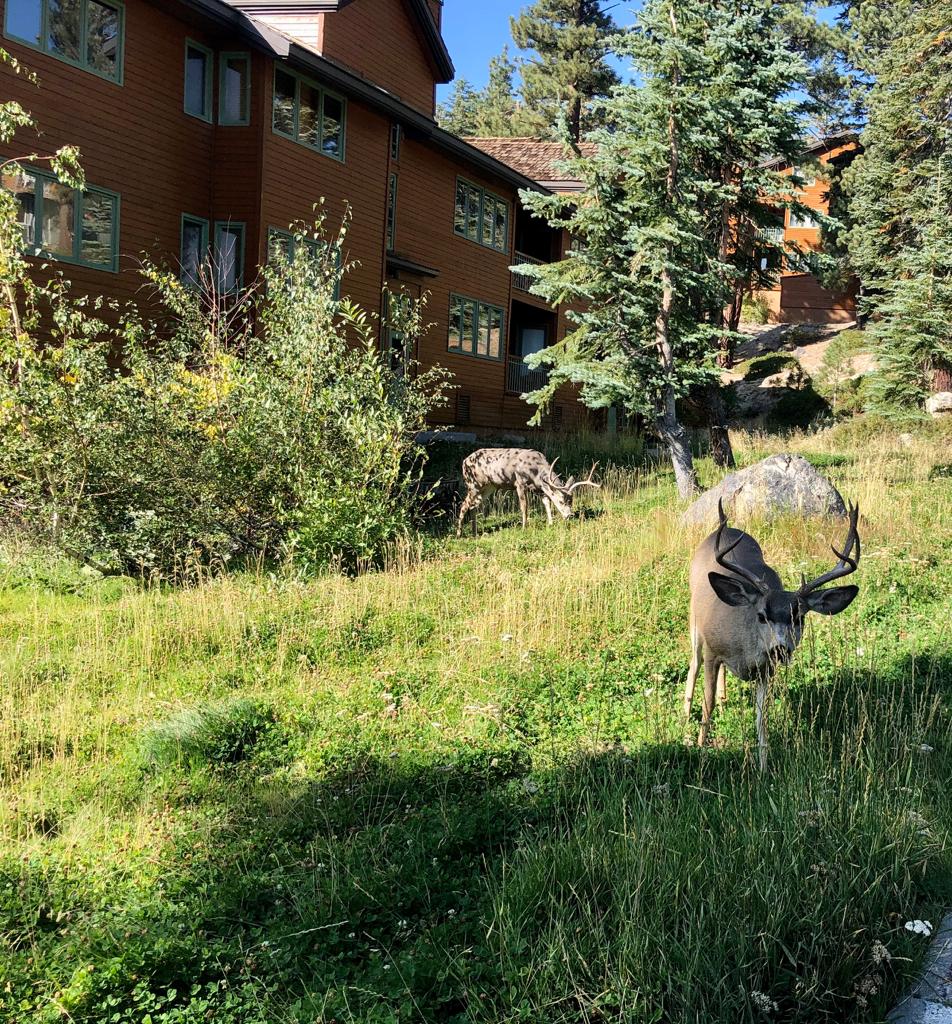Mule Deer are one of our most common native species here in Mammoth Lakes. And if you come to visit us anytime between March and September, you’re likely to see quite a few around town and on the trails.
Here are a few things to know about this majestic wild animal!
The deer you see in here Mammoth Lakes belong to the Round Valley Herd
Here in Inyo and Mono County, we have a subspecies of mule deer called California Mule Deer. And they make up a herd of about 3,000 called the Round Valley Herd.
During the winter, these hardy animals make the valley around Bishop their home. And during the summer, they migrate up to Mammoth Lakes and the surrounding High Sierras to eat and reproduce. While you won’t find them at quite as high of elevations as Sierra Nevada bighorn sheep, mule deer are surprising climbers! In fact, in historical documents, these deer were sometimes referred to as “granite bucks” because they are often found among granite peaks of up to 11,000ft.
Something special you should know about our deer is that you might see the same ones year after year. In the wild, mule deer live 9 to 11 years, on average. And, because they’re so loyal to their migration routes, it’s entirely possible to see the same returning deer if you visit Mammoth during the summer.

Mule deer are also called black-tailed deer
There are a few distinguishing features that can help you differentiate between mule deer and their close relatives, the white-tailed deer.
First are those ears! Mule deer ears can reach a span of 22 inches when they’re fully alert. Their ears are also more elongated and mule-like than their rounded-eared relatives.

Another way you can identify a mule deer is by their unique run. Unlike other species of deer, mule deer have a distinct jumping trot called “stotting.” They make it look easy, but that hopping escape takes a lot of energy! A common theory as to why they stot instead of run is that it shows their predators how powerful they are while also allowing them to jump over obstacles like bushes and downed logs.
Finally, you can tell a mule deer by the rump. Both white-tailed deer and mule deer have a white bottom. But a mule deer also has a black tip on their tail. For this reason, they’re also called black-tailed deer.
Bambi was almost a mule deer
We totally understand the urge to say, “Bambi!” every time you see a deer up here in Mammoth Lakes. But, if you want to be taxonomically accurate, Bambi was actually a white-tailed deer.
Interestingly, Walt Disney initially wanted his artists to model Bambi after mule deer, which would have been more familiar for his illustration team in California. At a certain point, however, the lead illustrator suggested swapping the mule-like version for a more East Coast spin, with white-tailed deer and lusher forest scenery.
We’re still a bit offended, but we can’t deny that white-tailed deer, with those fluffy white tails, are pretty cute.
Their favorite foods are part of the rose family
Unlike their close relatives, elk and cattle, deer are picky eaters! They can’t digest the wide range of vegetation that other ruminants can, so they tend to stick with easily-digestible members of the Rosaceae family, including bitterbrush, blackbrush, and mountain mahogany. They also love sagebrush!
We can imagine that they’re quite happy with this year’s super bloom, so you can expect to see more of them grazing to their heart’s content during the summer months.
Mule deer shed their antlers after the breeding season
During the breeding season, male deer use their antlers to show off their strength and spar over mates.
But once the breeding season is done, sometime between December and January, the mule deer shed their antlers in order to grow new ones.
If you find yourself hiking or fishing in the Eastern Sierra, you might come across one of these exciting finds! But, we would recommend against taking it home. While shed collecting is becoming a more popular pastime in the US, it’s pretty strictly regulated by the California Department of Fish and Wildlife. Unless you’re on National Forest Service land or Bureau of Land Management area, shed collecting is not allowed.
Mule deer have quite a few predators
The reason why mule deer have such large ears is because they have a long list of predators to watch out for! In the Eastern Sierra that includes puma, black bear, bobcats, coyotes, and of course, humans.
Fawns, which are usually left in a sheltered area while the herd grazes elsewhere, are particularly vulnerable to our area’s carnivores. But deer of any age need to keep those ears on a swivel.

How you can help keep Mammoth’s mule deer safe
Mule deer are a crucial member of our region’s natural ecosystem. So, we do everything we can to keep their populations healthy and thriving. Here’s how you can help:
Drive safely, especially at dawn and dusk
Mule deer are crepuscular, which means that they’re most active at dawn and dusk. Unfortunately, this is the time of day when our own vision is impaired while driving. According to the Eastern Sierra Land Trust, there were an estimated 2,000 deer killed in car collisions in Mono County alone between 2002 and 2015. So when you see deer crossing signs, slow down and keep an eye out.
One thing to remember about this 2023 season is that much of our area is covered in water right now. That means that deer might be looking for easier passages than their normal migratory routes.
Practice fire safety
Another major threat to our mule deer population is wildfire damage. Always practice fire safety while you’re up here in the mountains, using only designated fire pits, avoiding off road driving on dry grass, and putting out all campfires until the ashes are cold.
Don’t approach deer
Compared to some of our other wildlife, deer may seem approachable. But, it’s imperative that you give deer their space just like any other wild animal. One reason is that when they’re up here in Mammoth, they’re gearing up for the breeding season. That can make them unpredictable and irritable.
Another reason is for their own safety. Staying away from deer allows them to maintain their natural wariness of humans, a life-saving skill during hunting season.
If you see a fawn alone, leave it alone
As we mentioned, baby deer are often left by the herd in an area that Mom has deemed as safe. She’ll come back, so there’s no need to touch or move the fawn from its hiding place.
Keep dogs on leash
Even if your dog would never actually catch a deer, chasing after them causes stress for the herd. Unless your dog has amazing recall (and that’s never a given when they see a wild animal), keep your pup on a leash in areas where there are deer.
We hope you get to spot many mule deer during your next visit to Mammoth Lakes!
Mule deer are one of our favorite wildlife residents here in the Eastern Sierra. And because they’re so abundant during summer, you’re likely to see a few simply by looking out the window of your condo. All of our Mammoth Mountain Reservation properties offer views where deer like to graze, so whether you book a condo at Mountainback, Sierra Park Villas, or the Summit, you’re bound to catch a glimpse of our beloved large-eared mule deer!

Mule deer outside of Mountainback!
